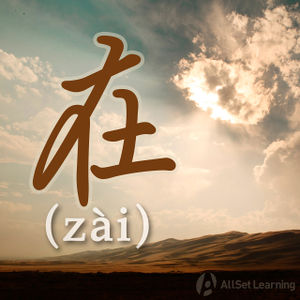Difference between revisions of "Expressing actions in progress with "zai""
m (Text replacement - "cellphone" to "cell phone") |
|||
| Line 30: | Line 30: | ||
* 我 现在 <em>在</em> 上班,不方便 离开。<span class="pinyin">Wǒ xiànzài <em>zài</em> shàngbān, bù fāngbiàn líkāi. </span><span class="trans">I am working now. It's not convenient for me to leave. </span> | * 我 现在 <em>在</em> 上班,不方便 离开。<span class="pinyin">Wǒ xiànzài <em>zài</em> shàngbān, bù fāngbiàn líkāi. </span><span class="trans">I am working now. It's not convenient for me to leave. </span> | ||
* 我们 <em>正在</em> 上课,请 你 等 一会儿。<span class="pinyin">Wǒmen <em>zhèngzài</em> shàngkè, qǐng nǐ děng yīhuì'r. </span><span class="trans">We are in class right now; please wait a moment. </span> | * 我们 <em>正在</em> 上课,请 你 等 一会儿。<span class="pinyin">Wǒmen <em>zhèngzài</em> shàngkè, qǐng nǐ děng yīhuì'r. </span><span class="trans">We are in class right now; please wait a moment. </span> | ||
| − | * 你 <em>正在</em> 开车,不 可以 玩 手机。<span class="pinyin">Nǐ <em>zhèngzài</em> kāichē, bù kěyǐ wán shǒujī. </span><span class="trans">You're driving right now. You can't play with your | + | * 你 <em>正在</em> 开车,不 可以 玩 手机。<span class="pinyin">Nǐ <em>zhèngzài</em> kāichē, bù kěyǐ wán shǒujī. </span><span class="trans">You're driving right now. You can't play with your cell phone. </span> |
* 你 给 我 打 电话 的时候,我 <em>正在</em> 跟 朋友 喝酒。<span class="pinyin">Nǐ gěi wǒ dǎ diànhuà de shíhou, wǒ <em>zhèngzài</em> gēn péngyou hējiǔ. </span><span class="trans">When you called me, I was drinking wine with friends. </span> | * 你 给 我 打 电话 的时候,我 <em>正在</em> 跟 朋友 喝酒。<span class="pinyin">Nǐ gěi wǒ dǎ diànhuà de shíhou, wǒ <em>zhèngzài</em> gēn péngyou hējiǔ. </span><span class="trans">When you called me, I was drinking wine with friends. </span> | ||
Revision as of 09:39, 8 March 2016
-
Level
-
Similar to
-
Used for
-
Keywords
在 (zài) and 正在 (zhèngzài) can be used as auxiliary verbs to express that an action is ongoing or in progress. This is often the equivalent of present continuous in English, which is how we express that an activity is happening now. You can use 正在 (zhèngzài) to put a little more emphasis on an action that is in progress right now.
Structure
Subj. + 在 + Verb + Obj.
or
Subj. + 正在 + Verb + Obj.
Examples
- 她 在 看 书。She is reading.
- 妈妈 在 打 电话。Mom is making a phone call.
- 谁 在 里面 洗澡?Who is taking a shower in there?
- 阿姨 正在 打扫 我们 的 房间。The cleaning lady is cleaning our room.
- 昨天 晚上 七点,我们 正在 吃 饭。 Yesterday at 7pm, we were eating dinner.
- 老板 在 开会,没 有 时间 见 你。The boss is currently in a meeting. He doesn't have time to see you.
- 我 现在 在 上班,不方便 离开。I am working now. It's not convenient for me to leave.
- 我们 正在 上课,请 你 等 一会儿。We are in class right now; please wait a moment.
- 你 正在 开车,不 可以 玩 手机。You're driving right now. You can't play with your cell phone.
- 你 给 我 打 电话 的时候,我 正在 跟 朋友 喝酒。When you called me, I was drinking wine with friends.
There is no need to worry too much about when to use 在 (zài) or 正在 (zhèngzài), since they basically mean the same thing. 正在 (zhèngzài) usually shows that the action is in progress. "在 (zài) + Verb" is more commonly used than "正在 (zhèngzài) + Verb," but both are okay to use. As mentioned, the only small difference is that 正在 (zhèngzài) emphasizes that the action is happening right now.
See also
- Aspect particle "zhe"
- Expressing actions in progress (full form) (more advanced usage)
Sources and further reading
Books
- Basic Patterns of Chinese Grammar (pp. 41-2) →buy
- Chinese: An Essential Grammar, Second Edition (pp. 60-1) →buy
- Integrated Chinese: Level 1, Part 1 (3rd ed) (pp. 209-10) →buy
- New Practical Chinese Reader 2 (新实用汉语课本2) (pp. 218-9) →buy



